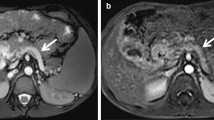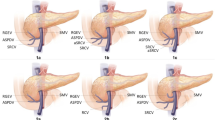Summary
The clinical application of contrast enhanced (CE) MR was evaluated. A total of 66 CE MR portograms were obtained by performing fast imaging with steady procession (FISP) technique on a 1. 5-T Siemens magnetom vision. A maximum intensity projection algorithm was also employed to include all vessels in a single image. The patency of portal venous system, the presence and extent of varices were also evaluated. The results showed that all images had diagnostic quality. Main portal vein (MPV) and its 4th–6th level-intrahepatic branches were visualized in 10 normal persons serving as control. The diameter of MPV, splenic vein and superior mesenteric vein was 1. 02±0. 21, 0.8±0.15, 0.8±0.26 cm respectively, which were significantly lower than that in portal hypertension patients (1. 38±0. 27, 1. 26±0.18, 1. 24±0.18 cm, respectively). In 23 preoperative cases of portal hypertension, dilated portal vein and tortuous enlarged splenic vein were found in 23 cases; esophageal and coronary varices in 12 and 19 cases, respectively. In 7 postoperative re-examined cases with portal hypertension, the flow velocity and flow of MPV were decreased in all cases and esophageal varices could still be observed in 3 cases. New vessels appeared in the great curvature of stomach in 2 cases. In 20 cases of liver carcinoma, occlusion of MPV or its intrahepatic branches were showed in 14, compression and dislocation of intrahepatic portal vein were found in 6. In other 6 cases, 2 were splenic venous thrombosis and 4 were tumors in the intestine or retro-peritoneum. It is concluded that three-dimensional CE MR portography is an accurate technique for evaluating the portal venous system. It is a reliable and noninvasive technique that can provide important information for the evaluation of patients’ condition before TIPSS and liver transplantation.
Similar content being viewed by others
References
Finn J P, Kane R A, Edelman R Ret al. Imaging of the portal venous system in patients with cirrhosis: MR angiography & Duplex Doppler sonography. AJR, 1993, 161: 989
Rodgers P M, Ward J, Baudouin C Jet al. Dynamic contrast-enhanced MR imaging of the portal venous system: Comparison with X-ray angiography. Radiology, 1994, 191: 741
Leung D A, Mckinnon G C, Davis CPet al. Breath-hold, contrast-enhanced, three-dimensional MR angiography. Radiology, 1996, 201:569
MRA 1997, 16(4): 220
Word J, Spencer J A, Guthrieet al. Liver transplantation: Dynamic contrast-enhanced magnetic resonance imaging of the hepatic vasculature. Clinical Radiology, 1996, 51: 191
Silverman J M, Podesta L, Villamil Fet al. Portal vein patency in candidates for liver transplantation: MR angiographic analysis. Radiology, 1995, 97: 147
Mcfarland E G, Kaufman J A, Sanjau Set al. Preoperative staging of cancer of the pancreas: Value of MR angiography versus conventional angiography in detecting portal venous invasion. AJR, 1996, 166: 37
Shirkhoda A, Kohez O, Amil Net al. Mesenteric circulation: Three-dimensional MR angiogralphy with a Gadolinium-enhanced multiecho gradient-echo technique. Radiology, 1997, 202: 257
Author information
Authors and Affiliations
Rights and permissions
About this article
Cite this article
Lian, Y., Xiangquan, K., Dingxi, L. et al. Preliminary clinical application of contrast-enhanced mr potography. Current Medical Science 19, 323–327 (1999). https://doi.org/10.1007/BF02886974
Received:
Published:
Issue Date:
DOI: https://doi.org/10.1007/BF02886974




